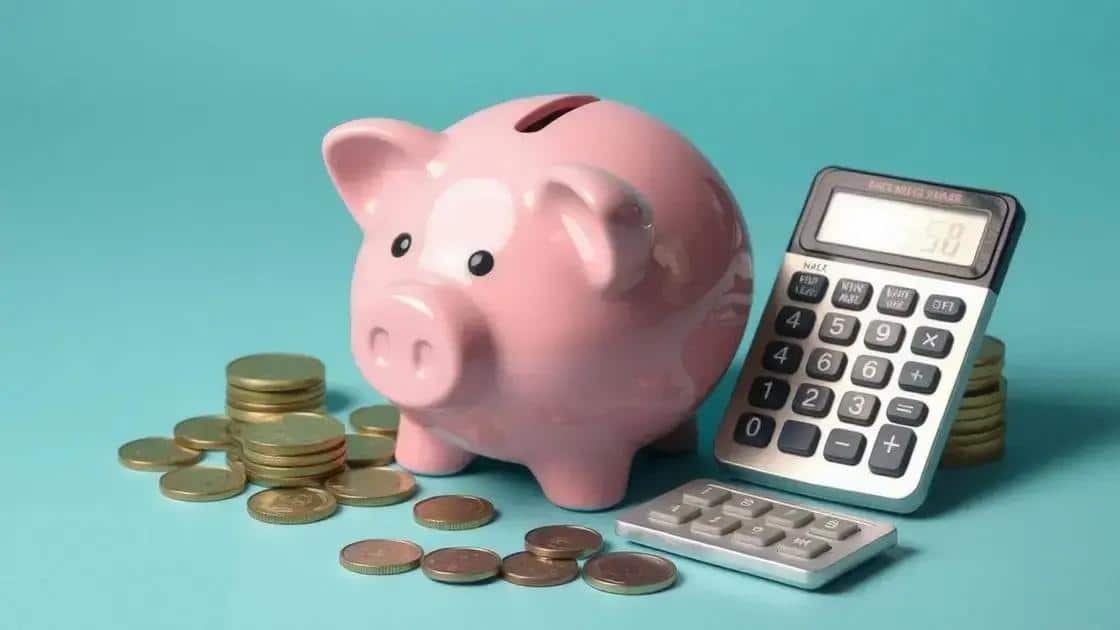Emergency savings fund strategies that really work

An emergency savings fund should ideally contain three to six months’ worth of living expenses, stored in a high-yield savings account to ensure quick access and earn interest while remaining secure for unexpected financial challenges.
Emergency savings fund strategies are crucial for anyone wanting financial security. Have you thought about how they can protect you in uncertain times? Let’s dive in!
Understanding the importance of an emergency savings fund
Understanding the importance of an emergency savings fund is the first step toward financial security. Every individual faces unexpected expenses at some point, whether it’s car repairs or medical bills. Knowing the significance of having an emergency fund can help you navigate these times without stress.
Having a safety net, or an emergency savings fund, allows you to cover sudden costs without falling into debt. This fund isn’t just about convenience; it’s about peace of mind. Your fund should ideally cover three to six months of living expenses. This amount gives you a cushion to rely on in case of job loss or unexpected financial burdens.
Key reasons to prioritize your emergency fund:
- Security: It offers a safety net for unplanned expenses.
- Stress Reduction: Knowing you have savings can ease anxiety.
- Financial Independence: You won’t need to borrow in a pinch.
Additionally, having an emergency fund can save you from using credit cards, which often have high interest rates. Rather than incurring debt, you can tap into your fund instantly. It’s like having a financial backup plan that can help you stay afloat.
Furthermore, once you establish your emergency savings, developing consistency in contributions is crucial. Make it a habit to save a portion of your income monthly. This not only helps the fund grow but instills discipline in your financial habits. You might find that setting up automatic transfers to your savings account makes it easier to build your fund.
In summary, the importance of an emergency savings fund cannot be overstated. It’s a vital aspect of financial planning that promotes stability and security, allowing you to face life’s uncertainties with confidence.
How much should you save for emergencies?
Knowing how much you should save for emergencies is crucial for your financial well-being. Starting with savings goals can give you clarity and direction. A good rule of thumb is to aim for three to six months’ worth of expenses. This amount can act as a safety net during unforeseen events.
To determine your specific target, you’ll need to calculate your monthly expenses. This includes rent, utilities, food, transportation, and other regular bills. Once you know your total, multiply it by the desired number of months you want to save.
Steps to calculate your emergency savings:
- List your essential monthly expenses.
- Calculate your total expenses per month.
- Decide on the time frame—three to six months is recommended.
For instance, if your monthly expenses total $3,000, you should ideally have between $9,000 and $18,000 set aside. This fund will help cushion financial blows, whether they stem from job loss or unexpected repairs.
Bear in mind that different situations might require different savings amounts. Many families find it good practice to adjust their goals based on changes in their lives. If you have children or a mortgage, consider aiming for a larger fund. It’s fine to start small and gradually build your savings, increasing contributions as you can.
Factors to consider when setting your savings goal:
- Your job stability and income variability.
- The number of dependents you have.
- Your monthly debt obligations.
Ultimately, understanding how much you should save for emergencies helps you prepare for life’s unpredictability and reduces financial stress. Regularly reassessing your needs allows you to modify your goals to suit your current lifestyle.
Top strategies to build your emergency fund

Building your emergency fund is essential for financial stability. There are various strategies to help you grow this fund effectively and ensure you are prepared for unexpected expenses. Using these approaches will simplify the process and keep you motivated.
One effective way to build your fund is to set clear and achievable savings goals. Start by determining the total amount you wish to save and break it down into smaller, manageable milestones. This can make the overall goal less overwhelming and provide a sense of accomplishment along the way.
Key strategies to build your emergency fund:
- Automate your savings: Set up automatic transfers from your checking account to your savings account. This way, you won’t have to worry about forgetting to save each month.
- Reduce unnecessary expenses: Review your monthly budget and identify areas where you can cut back. These savings can be redirected to your emergency fund.
- Increase your income: Consider taking on a part-time job or side gig. The extra income can boost your savings more quickly.
Another important aspect of building your emergency fund is choosing the right account to house your savings. Look for high-yield savings accounts that offer competitive interest rates. This can help your money grow while remaining easily accessible when you need it.
Ensure that your fund is separate from your regular spending account. Keeping it in a different account can prevent you from using it for non-emergencies. When you start building your emergency savings, stay consistent and make saving a priority.
Additional tips to enhance your emergency fund:
- Use windfalls wisely: Put any unexpected money, like bonuses or tax refunds, directly into your emergency fund.
- Track your progress: Regularly check how much you’ve saved. This can encourage you to stay committed to your goal.
- Celebrate milestones: Reward yourself when you reach specific savings goals to keep motivation high.
In summary, utilizing these strategies can significantly help you build and maintain your emergency fund. A well-funded reserve prepares you for life’s surprises and contributes to your overall peace of mind.
Where to keep your emergency savings safe
Choosing where to keep your emergency savings safe is a vital step in managing your finances. The right account can help you grow your savings while keeping your money easily accessible when you need it most. Let’s explore your best options for storing these essential funds.
The most common choice for emergency savings is a high-yield savings account. These accounts typically offer higher interest rates than traditional savings accounts, allowing your money to grow. Look for online banks, as they often provide better rates due to lower overhead costs. Make sure the bank is insured by the FDIC or NCUA, which protects your deposits.
Other safe options include:
- Money market accounts: These accounts often come with higher interest rates and limited check-writing capabilities, making them a good choice for emergency funds.
- Certificates of deposit (CDs): While typically requiring you to lock your money for a set term, some CDs offer features that allow for early withdrawal without penalties, which can be beneficial for emergencies.
- Cash management accounts: Offered by financial technology companies, these accounts combine features of checking and savings accounts and often come with competitive interest rates.
When selecting an account, consider not just the interest rate but also the fees associated with maintaining it. Look for accounts with no monthly maintenance fees, and ensure that you have easy access to your funds when necessary. Avoid tying your emergency savings to investments that may fluctuate, such as stocks or mutual funds, because you need a stable source of funds when emergencies arise.
Another crucial tip is to keep your emergency fund separate from your everyday spending accounts. This way, you won’t be tempted to dip into your savings for non-emergencies. You might consider setting up automatic transfers to your emergency savings account each month. This can create a habit of saving and ensure your fund grows steadily over time.
Final thoughts on safety for your savings:
- Regularly review your account: As interest rates change, ensure your savings are still earning competitive rates.
- Keep your information secure: Monitor your account for unauthorized transactions and use strong passwords.
When you find the right place to keep your emergency savings safe, you create a solid foundation for financial stability and peace of mind.
Tips for maintaining your emergency savings fund
Maintaining your emergency savings fund is just as important as creating it. Many people make the mistake of neglecting this fund after they’ve met their savings goal. Here are some solid tips to ensure your fund remains healthy and accessible.
Regular contributions are a key factor to maintaining your savings fund. Even after reaching your target, consider adding a specific amount each month to keep your savings growing. This habit can make it easier to adjust your fund whenever needed. Additionally, it helps account for inflation, which erodes the purchasing power of your savings over time.
Additional strategies for maintaining your fund:
- Set reminders: Use calendar alerts or apps to remind you to check your fund regularly.
- Evaluate your savings goals: Periodically reassess your financial situation. If your expenses increase, adjust your savings goal accordingly.
- Avoid unnecessary withdrawals: It can be tempting to dip into your emergency fund for non-emergencies. Make sure to restrict your withdrawals to genuine emergencies only.
Another aspect of maintaining your fund involves monitoring your savings account. Look out for any fees associated with your account, as these can eat into your savings. Choose an account that offers high interest with minimal or no fees to maximize your returns.
A regular check-in on your emergency fund can help you see how well you are doing. Track your progress and celebrate small milestones, as this can motivate you to continue saving. You can also involve your family in this process by setting shared savings goals that everyone can participate in to boost commitment.
Best practices for sustaining your emergency savings:
- Keep it separate: Maintain your emergency fund in a different account, which can help prevent mixes with daily spending funds.
- Build a safety net: Aim for three to six months’ worth of living expenses, depending on your job stability and personal circumstances.
- Review your budget: Regularly reviewing your budget can help you identify new opportunities to increase contributions to your fund.
Staying diligent about your emergency savings fund will help keep it secure and ready for unexpected situations. By establishing regular saving habits and being mindful of your financial landscape, you’ll be well-prepared for whatever comes your way.
FAQ – Frequently Asked Questions About Emergency Savings Funds
What is an emergency savings fund?
An emergency savings fund is money set aside for unexpected expenses or financial emergencies, such as medical bills or car repairs.
How much should I save in my emergency fund?
It’s recommended to save three to six months’ worth of living expenses in your emergency fund to ensure you can cover essential costs.
Where should I keep my emergency savings?
Consider keeping your emergency savings in a high-yield savings account for easier access and to earn interest on your funds.
How can I maintain my emergency savings fund?
To maintain your fund, regularly contribute to it, set clear savings goals, and avoid using the money for non-emergency expenses.






